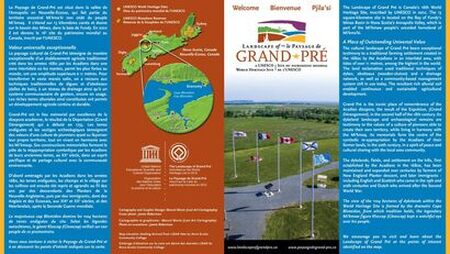From the View Park on Old Post Road in Grand Pré, you can see the Memorial Church at Grand-Pré National Historic Site, Look north to see the expansive dykelands of the UNESCO World Heritage Site holding back the high tides of the Bay of Fundy. Farther north of the dykelands is Long Island and farthest off in the distance are the cliffs of Blomidon. East and west are dykes protecting the active agricultural landscape.
|
Live WebCam |
|
|
UNESCO World Heritage Site |
|
UNESCO World Heritage Sites have cultural and/or natural significance so exceptional as to transcend national boundaries and be of common importance for present and future generations.
|
|
Discover the Landscape |
|
Discover the beautiful landscape of Grand Pré, see the incredible views of Blomidon, stroll the beach and witness the high tides. Learn about the incredible history and the agricultural masterpiece that is Grand Pré.
|
|
Visit Grand Pré |
|
The View Park on Old Post Road in Grand Pré, was created as a legacy to the local communities who supported the 2012 inscription of the Landscape on UNESCO’S World Heritage List.
|
|
Historical Relevance |
|
The Deportation Cross was erected in 1924 to mark the location from which the Acadians were deported in 1755. It was relocated to Horton Landing (Vieux Logis) in 2005 where Acadian families boarded small boats.
|
|
Agricultural Excellence |
|
The Acadians were the first people in North America to establish their settlements by transforming intertidal zones using the innovative aboiteau technology to take advantage of the fertile salt marshes for agriculture.
|
|
Archaeologically Significant |
|
The Grand-Pré Archaeological Field School Project led by Dr Jonathan Fowler of St Mary's University, made several significant discoveries that help piece together the history of Grand Pré.
|
|
Brochure |
|
|
|
Projects |
|
Visitor Experience Concept and Feasibility Study ReportThe final report of a visitor experience concept and feasibility study for the Landscape of Grand Pré World Heritage Site. The Board of Directors is pleased to share the report in order to generate additional discussion and input regarding the development of a visitor experience concept.
|
Protecting communities and agricultural land from climate changeNova Scotia’s dykeland system protects agricultural land, public infrastructure, cultural assets commercial and residential properties throughout the province. The system needs to be upgraded to reduce the potential economic, environmental and social effects of climate change as storms increase in intensity and frequency.
|
Sign Up For Our Newsletter |





